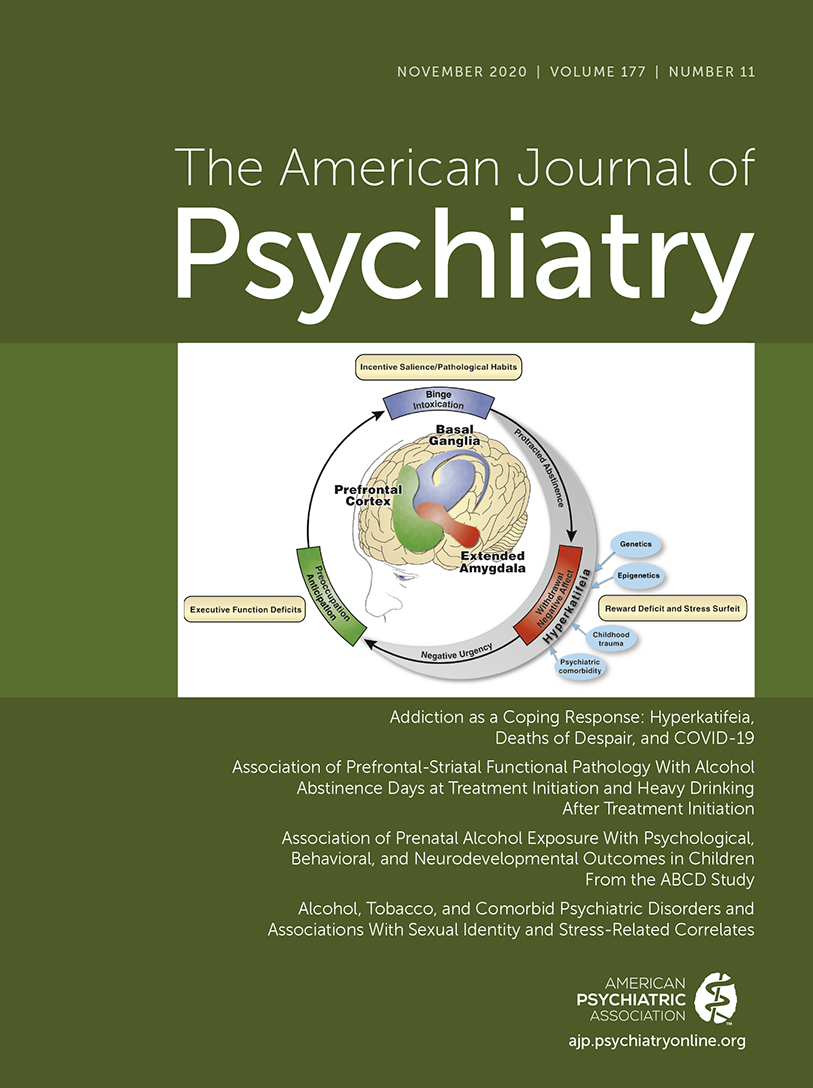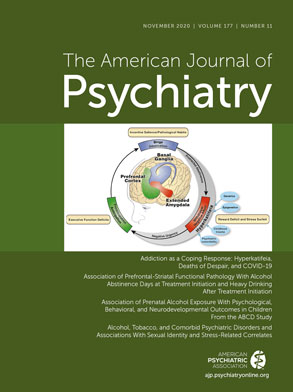Like celestial navigation, multimodal imaging approaches help guide us closer to the truth through the power of triangulation. Unlike the certainty of location that converging sight lines to stars can provide, however, neural events and states are often only shadows of ideas, especially in the highly interconnected realm of systems neuroscience. It is the confluence of multiple approaches in support of an idea that can provide needed confidence as we try to discern the ever-elusive inner workings of the human brain. This month’s issue features an elegant demonstration of just such a triangulation. A unique MR imaging approach for quantifying neuromelanin, in concert with positron emission tomography (PET) imaging observations, both of which were validated by good analytical chemistry, led Cassidy et al. (
1) to assert a unifying proposal of altered nigrostriatal dopamine function associated with cocaine use.
There are two contiguous regions in the brainstem from which dopamine neurons send diverging innervations throughout the forebrain: the substantia nigra and the ventral tegmental area. The former contributes more projections to dorsal and motor-associated striatum, while the ventral tegmental area is more likely to innervate reward-related ventral striatum. Substantia nigra, or “black substance,” is so named because of the presence of neuromelanin, formed through a series of reactions and aggregations that begin with the oxidation of cytosolic dopamine, promoted in part by the presence of ferric iron (Fe
+3). The reactive dopamine-
ortho-quinone produced can bind to aggregated and β-structured proteins in the cytosol, and subsequent oxidative polymerization then initiates formation of melanin-protein complexes, which polymerize to pheomelanin moieties that can bind high amounts of metals such as iron, as well as lipids and proteins. Macroautophagy of pheomelanin and fusion with lysosomes and autophagic vacuoles produce the enduring neuromelanin organelles that accumulate over the lifetime of a nigral dopaminergic neuron. It is only on the death of the neuron that the neuromelanin is removed, resulting in the bleaching of the substantia nigra that occurs in Parkinson’s disease noted by Tretiakoff a century after Parkinson’s initial description (
2). Quantitative analysis of postmortem neuromelanin by Zecca and colleagues (
3) revealed a monotonic increase in neuromelanin with age in non-Parkinson’s subjects, and elegant work by Sulzer and colleagues demonstrated a mass action effect of cytosolic dopamine on neuromelanin formation. Thus, neuromelanin content reflects an integration of cytosolic dopamine concentration over the life of the neuron (
2).
The sequestration of iron by neuromelanin renders it paramagnetic, and therefore it has a unique MR signature relative to nonmelanotic tissue. In a prescient observation, Zecca and colleagues opined that “the development of neuromelanin in vivo imaging techniques may offer diagnostic and disease staging measurements matching the available tools used to monitor striatal dopamine depletion.” That in vivo method, neuromelanin-sensitive MRI (NM-MRI), was developed soon thereafter (
4). It was made possible by the interaction between neuromelanin and iron—other tissues equally rich in iron but with less neuromelanin do not produce MR signal hyperintensities. Those hyperintensities obtained with specific NM-MRI acquisition parameters are quantified as a contrast-to-noise ratio (CNR) in comparison with nearby melanin-lacking tissue. (See the excellent review by Sulzer and colleagues [
2] for more on neuromelanin formation, its diagnostic use, and the physics of its detection with MR imaging.)
While it had been demonstrated that NM-MRI CNR could distinguish populations with Parkinson’s disease from control subjects, it was only recently that sufficient resolution was demonstrated to support investigation of individual differences in the absence of neurodegeneration (
5). That earlier study by Cassidy et al. was a tour-de-force validation of a voxelwise NM-MRI approach capable of resolving nigral subregions by imaging postmortem sections followed by dissection along a grid with chemical analysis, demonstrating that regionally varying tissue levels of neuromelanin correlated with the NM-MRI CNR. That approach was then combined with a multimodal data set of molecular PET and fMRI, demonstrating that the in vivo NM-MRI CNR was related to both amphetamine-induced dopamine release in the dorsal striatum and resting blood flow within the substantia nigra. Specifically, the NM-MRI CNR in substantia nigra correlated positively with raclopride displacement in the dorsal striatum from the D
2 receptor by endogenous dopamine released by amphetamine, which acts on presynaptic vesicular and cytosolic pools in dopamine neurons (
6). This suggests that individual differences in the size of these releasable dopamine pools correlates positively with NM accumulation. In their earlier study, Cassidy et al. also measured resting cerebral blood flow in the substantia nigra (with arterial spin labeling) as a measure of basal neural activity, and this also correlated with the NM-MRI CNR in nigra only, not an anatomically contiguous reference region, or whole brain gray matter. Thus, the correlations with both a PET measure of the presynaptic amphetamine-releasable pool of dopamine and a measure of resting neural activity in the substantia nigra indicate that NM-MRI CNR reflects individual differences in presynaptic dopaminergic function. The icing on the cake was applied in the demonstration that symptom severity, known to relate to dopaminergic function in the associative striatum (
7), was also significantly correlated with NM-MRI in a population of patients diagnosed with schizophrenia and a prodromal population considered at high risk of schizophrenia.
Having validated the utility of an MR approach for probing dopamine function in clinical non-neurodegenerative populations, Cassidy et al. have now used their approach to probe dopaminergic differences between control and cocaine-using populations. Given dopaminergic mediation of cocaine reward and its dysfunction linked to addiction, there is an abundance of literature within which to frame predictions. Preclinical studies of sensitized increases in stimulant-elevated extracellular dopamine in rodents were the basis for assuming that the same should occur in humans. However, in a landmark study, Volkow and colleagues (
8) demonstrated (using PET and raclopride displacement) that exactly the opposite is observed—a blunted presynaptic response. This has been confirmed in other human imaging studies (
9), and nonhuman primate studies have also confirmed a divergence from the observations in rodents (
10–
12).
Thus, given the evidence of reduced dopaminergic function in human and nonhuman primates following chronic cocaine use, and that NM-MRI CNR correlates with the ability of a psychostimulant to increase extracellular dopamine, the prediction by Cassidy et al. was that a cocaine-using population should have a reduced NM-MRI CNR. In order to use NM-MRI, it was critical that cocaine use is not associated with dopamine neurotoxicity or risk for Parkinson’s disease, which would directly affect melanin levels through loss of dopamine neurons. Also, correcting for age was necessary, given the known relationship between age and neuromelanin accumulation (
3). The results obtained were clear and unambiguous: cocaine use is associated not with reduced NM, but instead with elevated NM.
The discrepancy between predicted results based on PET and postmortem measures of presynaptic dopamine function provided a glimpse into altered dopamine function in cocaine use disorder. The combination of blunted dopamine release in the striatum with elevated NM in the substantia nigra suggested that dopamine is distributed differently intracellularly in cocaine users compared with control subjects, but how? If synthesis were reduced, one would expect both decreased release and decreased NM, but what was observed instead were opposite effects. What was needed was a mechanism that explained a redistribution of dopamine such that the releasable pool was diminished while the cytosolic pool was enhanced. Triangulation of other imaging approaches in humans and nonhuman primates provided the answer.
Using PET imaging, Narendran et al. (
13) had observed that, consistent with postmortem results, cocaine users had reduced measures of VMAT2, the vesicular monoamine transporter that can be labeled with
11C-(+)-dihydrotetrabenazine ([
11C]DTBZ). This would be consistent with the measures of reduced dopamine release, because VMAT2 is required for uptake of dopamine into vesicles from the cytosol, where it is synthesized—less uptake into vesicles would leave less available for release. That observation was significant, because reduced release was also linked to an increased risk of relapse among cocaine users attempting to quit (
9). But was this a consequence of cocaine use, or a predisposing risk factor? A convergence between clinical and preclinical studies provided the answer. Longitudinal PET imaging with [
11C]DTBZ in rhesus macaques before and after 16 months of cocaine self-administration indicated a 25% reduction in VMAT2. It was important that the preclinical model for cocaine use was a primate, because these reductions in VMAT2 are not seen in rodents. Most importantly, by virtue of the experimental control that animal studies can provide, Narendran et al. established causality by cocaine in reducing VMAT2.
The confluence of these results from other imaging modalities and animal models enabled Cassidy et al. to provide a parsimonious and compelling mechanism for their unanticipated results. Cocaine, through a yet-to-be-determined process, causes a reduction in vesicles in dopamine neurons, with a resulting redistribution of dopamine to the cytosol, where, in the cell body, increased NM results. Exploratory analyses with functional MRI during a monetary incentive delay task did not reveal any relationship between the blood-oxygen-level-dependent (BOLD) activation in ventral striatum and the NM-MRI measures in the substantia nigra shown to be altered by cocaine use. This could be due to less neuromelanin in the more medial and dorsal regions of the ventral tegmental area and substantia nigra that project to the ventral striatum, which is most engaged by the monetary incentive delay task, rendering NM-MRI less useful for interrogating dopamine function in the ventral striatum. Also unclear is the extent to which alterations in dopamine signaling contribute to BOLD findings (
14).
The advantages of the approach so successfully developed and applied by Cassidy et al. are many. PET imaging, the most widely used approach for exploring aspects of dopamine function in humans, is expensive, and it cannot be used in youths because of the risks of radiation exposure. NM-MRI offers an inexpensive approach for observing an aspect of dopaminergic function which could be especially informative in longitudinal approaches or in sampling larger populations. It isn’t perfect, as no technique is. However, combined with other modalities and approaches, it is helping to point the way toward intersections that will help us understand behavioral, psychiatric, and neurological disorders linked to dopaminergic dysfunction.
Acknowledgments
Supported by the NIDA Intramural Research Program.

